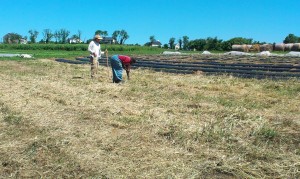Thanks to a generous donor, Louis Eby (who happens to be Red Wiggler’s first farmer), we purchased a roller crimper for our walk behind BCS this spring. In an earlier post, we suggested that you stay tuned to find out how our roller crimper experiment was evolving and the early results are in. So far, the potato field with rye and vetch in the aisles does not have nearly as many Colorado Potato Bugs as the field without. This is a huge help- the plants look healthy and we spend less time scouting for bugs! While the rolling didn’t go exactly as we planned, the overall effect seems to be a success, and we are looking forward to harvest time so we can compare yields and see how we did. Read on for the complete story.
At the start of May, we offered a blog post that explains the benefits of using a roller crimper; the basic idea is that a cover crop of hairy vetch and rye grow in a field slated for production. When it is time to plant, the roller crimper goes through the field, bending all the cover crop to the ground and killing it, while holding the resulting straw in place. In studies published by the USDA Beltsville Agricultural Research Center, cover crops like hairy vetch and rye were found to suppress the population of Colorado Potato bugs, one of the field pests that we spend lots of time battling (mostly by hand harvesting the larvae and mature bugs from our plants). In theory, the straw deters the bugs, conserves moisture, and adds nutrients as it breaks down, while the lack of tilling strengthens the soil. This combination of benefits stands to save us significant time and resources.
The plan was to experiment with it in two spots: the potato field and the field slated for the 3rd succession planting of tomatoes and squash.
Our first go had us rolling through the mature patch of rye and hairy vetch in mid May, as the purple flowers of the hairy vetch were coming into bloom. By catching it in bloom, we hoped to maximize the kill rate on the vetch and rye.
Using and setting up the BCS to use the roller crimper was fairly easy. We changed out the implements, loaded the roller with 200 pounds of barbell weights, and we were ready to go. Getting the hang of steering the roller crimper was the most challenging as it was like pushing a trailer in front of you.
In our experience, using the roller crimper on hills and uneven ground made it harder for the crimper to roll and kill the vetch. Were able to kill the rye in the bumpy patches, but not the hairy vetch, perhaps because the roller did not get even contact on uneven ground. This fall, we plan adjusting the seed percentages by increasing the rye and decreasing the vetch, and we’ll do some extra field preparation before the cover crop is planted to account for what we’ve learned.
Where the vetch didn’t crimp and die, we went ahead and mowed the vetch to kill it and have now planted summer squash into the mowed residue. We also planted the same varieties into laid plastic as a control, so we will be able to compare yield later in the season. Fingers crossed that the rolled down rye and vetch is successful, because if it is, we will be able to reduce our use of plastic while we continue to conserve moisture and add nutrients back into the soil!

